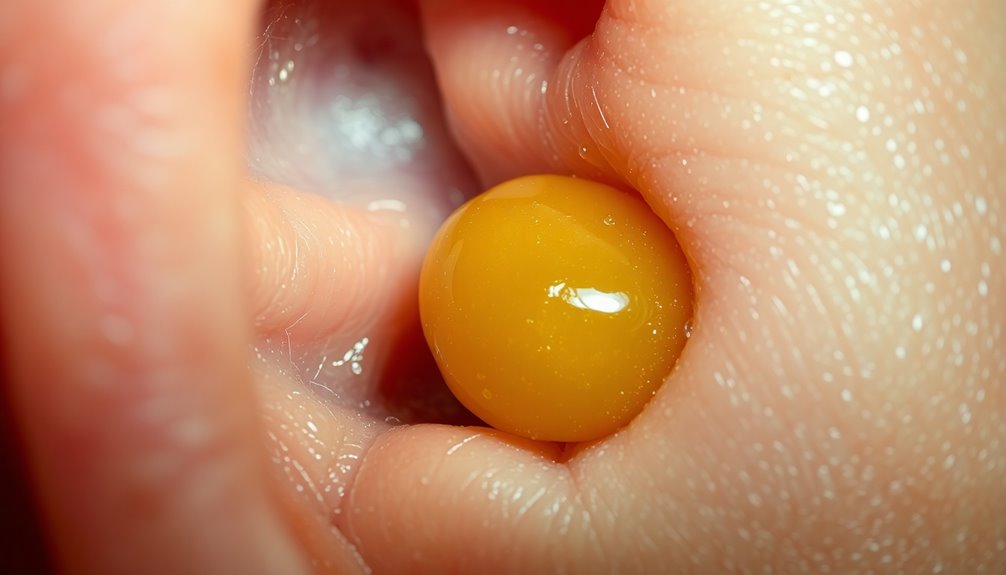Pseudomonas aeruginosa has a unique, fruity smell that's often compared to grape juice. This pleasant aroma comes from a compound called aminoacetophenone. You might spot this smell in places like hospitals or wastewater treatment facilities, where it indicates the presence of the bacteria. The fruity scent can evoke feelings of nostalgia for sweet foods and acts as an important warning sign for possible infections. Recognizing this odor helps healthcare professionals respond quickly to potential problems. So, if you find yourself curious about how this smell impacts health, there's more to explore about this fascinating bacterium!
Key Takeaways
- Pseudomonas aeruginosa emits a distinctive fruity or grape juice-like odor primarily due to the compound aminoacetophenone.
- The fruity aroma is often compared to sweet corn tortillas and can evoke nostalgia linked to certain foods.
- This unique scent serves as a key identifier in clinical settings, especially in infected wounds.
- Odor intensity can vary based on environmental factors such as nutrient availability and temperature.
- Recognizing the fruity aroma can aid healthcare professionals in early detection of potential infections.
Introduction
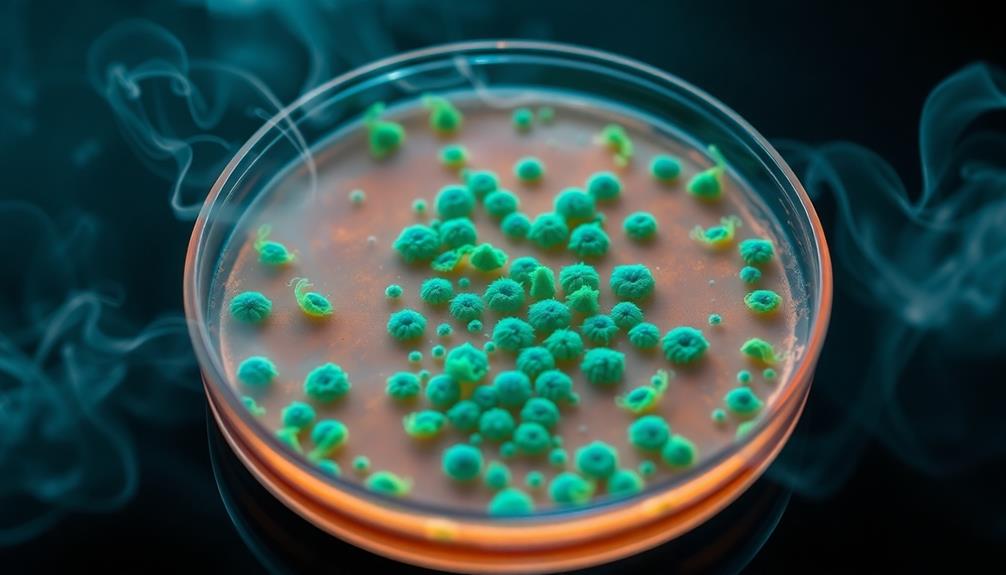
When you encounter a distinctive fruity or grape juice-like odor in a clinical setting, it often signals the presence of Pseudomonas aeruginosa. This microorganism is fascinating yet can be a bit tricky. It's known for producing a unique scent, mainly due to a chemical called aminoacetophenone. This fruity aroma sets Pseudomonas aeruginosa apart from other bacteria, like Enterobacteriaceae, which usually give off a much less pleasant smell.
Proper handling and storage of essential oils, for instance, can help maintain their potency, similar to how environmental conditions affect the strength of this bacterial odor essential oils safety.
Recognizing this sweet scent can be crucial in helping healthcare professionals identify infections early. The fruity smell acts as an important clue during microbiological analysis and clinical diagnostics. Isn't it interesting how something as simple as a smell can guide doctors in making decisions?
Furthermore, environmental conditions can affect the strength and quality of the odor. Factors like temperature and nutrient availability play a big role in how strong that fruity aroma becomes.
Description of the Smell
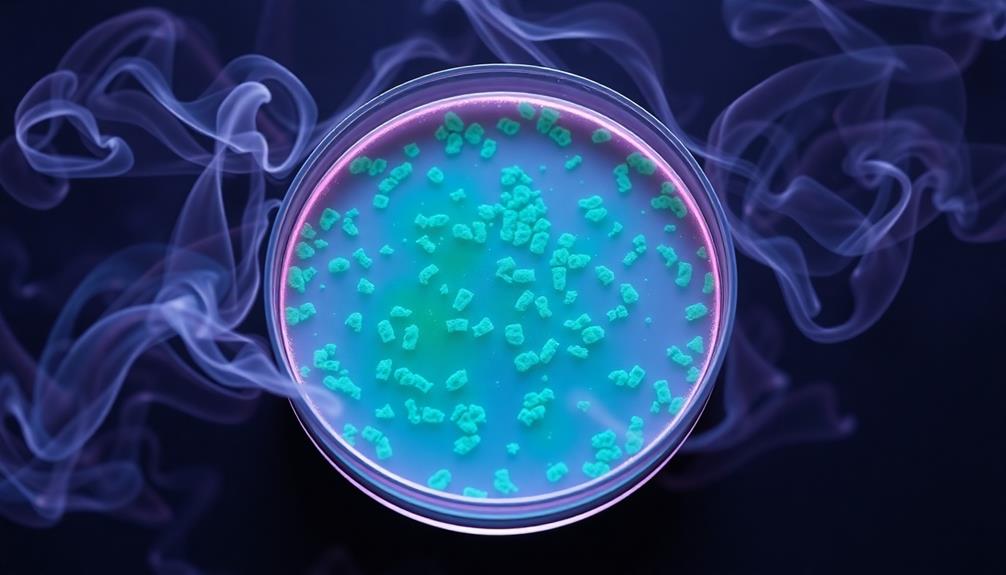
Emitting a distinctive fruity or grape juice-like aroma, Pseudomonas aeruginosa captures attention with its unique scent profile. This intriguing smell is largely due to a compound called aminoacetophenone.
Interestingly, certain foods and beverages, like coffee, can also possess appealing aromas that enhance our experience, highlighting the significance of fresh insights on health benefits. When you catch a whiff, you might also think of corn tortillas or even artificial grape flavor. Isn't that fascinating?
This bacterium's odor isn't just an interesting quirk; it's a key identifying feature in microbiological analysis. The fruity aroma can actually help you detect Pseudomonas in clinical samples and environmental assessments.
Imagine walking into a lab and instantly recognizing the smell—like a fruit stand with a twist!
Understanding the characteristics of Pseudomonas aeruginosa's odor is crucial, especially in healthcare settings where infection control is vital. By knowing what to look for, you can aid in diagnosis and ensure proper treatment.
Source and Composition
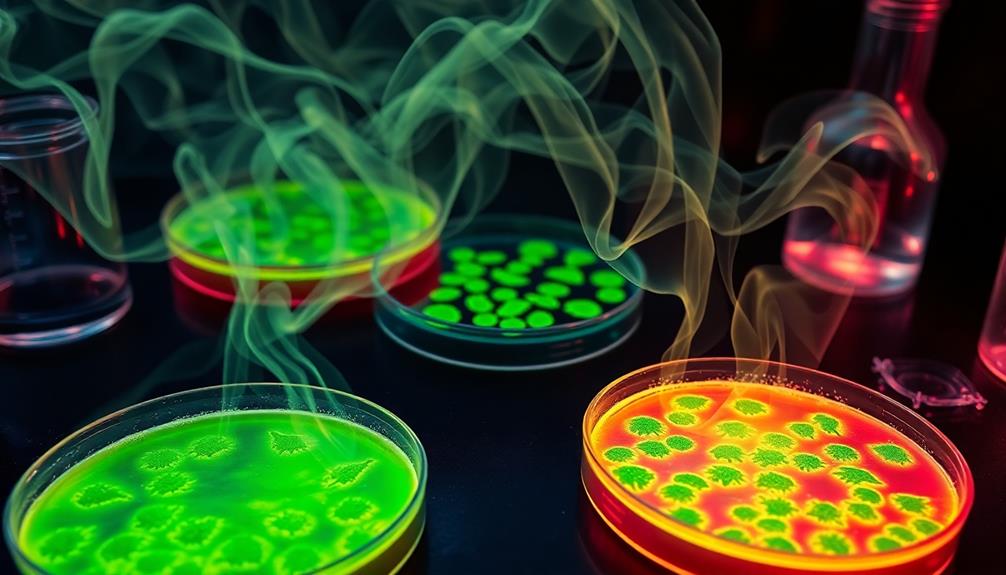
The source of Pseudomonas aeruginosa's distinctive smell lies in its metabolic byproducts, particularly aminoacetophenone. This compound gives off a fruity scent, often compared to grape juice or sweet corn tortillas. It's like a quirky signature for this bacterium!
You might find that these smells can sometimes mask or mingle with foul smells, but the fruity aroma stands out. Interestingly, just like how color accuracy enhances visual experience in projectors, the unique volatile organic compounds (VOCs) created by Pseudomonas act like tiny fingerprints, helping scientists identify whether it's present in a sample.
The intensity and unique characteristics of the odor can change based on environmental factors, like nutrient availability and temperature. So if the conditions are just right, you might notice that the fruity scent becomes even more pronounced!
Understanding these smells isn't just for fun; it plays a crucial role in microbiological analysis and clinical samples. By recognizing the sweet, fruity odors, you can tell a lot about what's going on in an environment.
Typical Scenarios or Environments

You might encounter the distinctive fruity aroma of Pseudomonas aeruginosa in various scenarios, particularly in clinical and environmental settings.
In hospitals, for instance, this bacteria often reveals its presence through infected wounds or respiratory samples. The sweet, grape juice-like smell can help microbiologists identify Pseudomonas quickly, setting it apart from other bacteria that might emit more unpleasant odors.
Outside of healthcare, you can find this fruity scent in wastewater treatment facilities. Here, the presence of Pseudomonas aeruginosa indicates active microbial processes, which are vital for breaking down waste. The smell can be a sign that the bacteria are doing their job!
It's worth noting that the intensity of the aroma can change based on environmental conditions, like nutrient availability and temperature. So, if you notice that grape-like scent getting stronger or weaker, it might be due to these factors.
Whether you're in a lab or near a treatment plant, recognizing the unique odor of Pseudomonas aeruginosa can be quite helpful. It's a fascinating example of how microorganisms communicate with us through smell!
Emotional or Cultural Associations
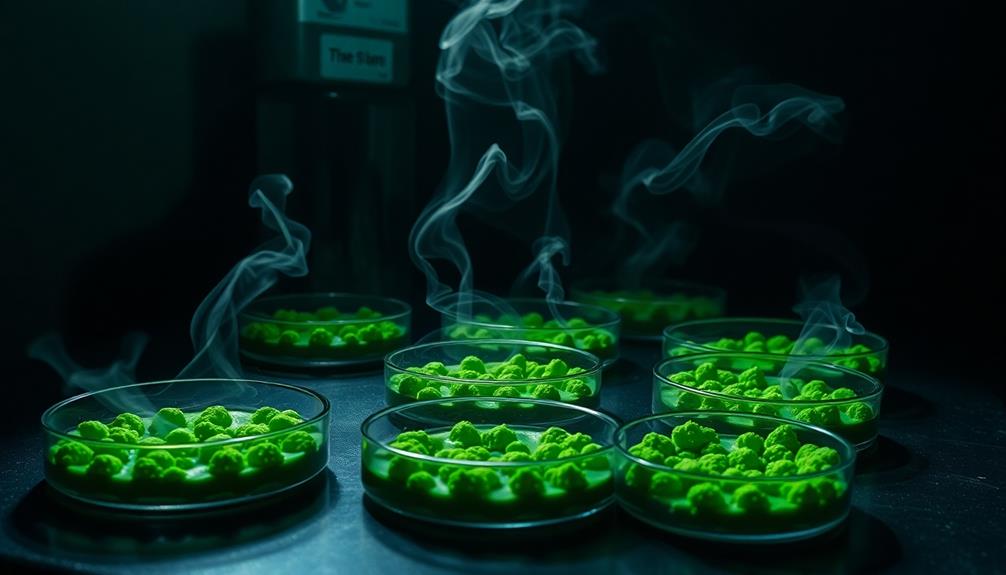
Encountering the distinctive fruity aroma of Pseudomonas aeruginosa can trigger a range of emotional responses and cultural associations. You might find yourself feeling nostalgic, as this microbial scent often reminds people of sweet foods like grape juice.
It's fascinating how smells can connect us to memories!
In many cultures, the scent of Pseudomonas can influence attitudes toward cleanliness and hygiene. When you smell it in a hospital, your mind might jump to thoughts of contamination and infections, making you more aware of your surroundings.
This heightened concern can change how you feel about visiting medical facilities.
Unfortunately, the odor associated with decay can carry negative vibes too, affecting how people think about microbial health.
Yet, the unique smell of Pseudomonas aeruginosa can also spark curiosity! It invites you to dive into scientific discussions, exploring the world of microbial scents and their roles in health and ecology.
Health or Safety Considerations
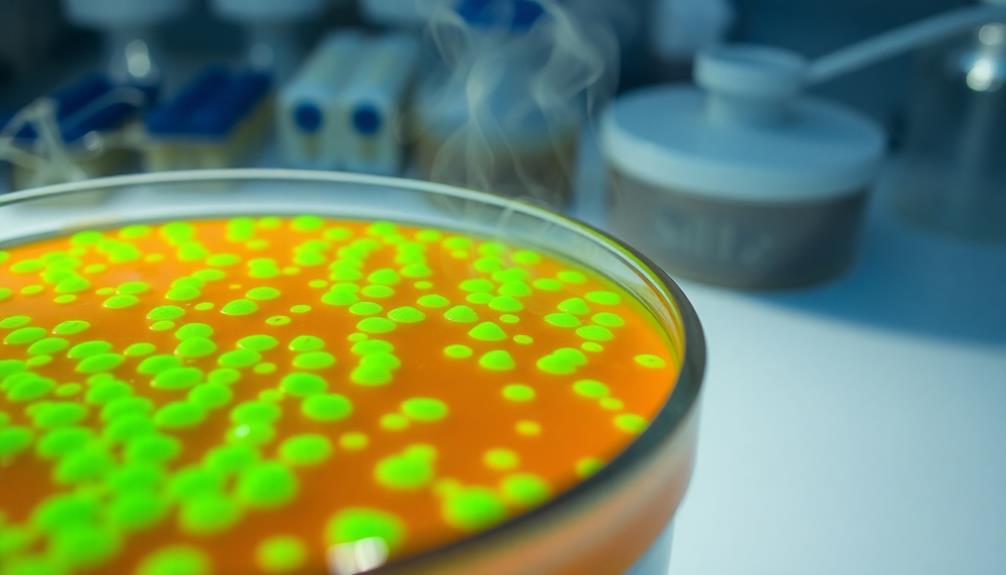
Recognizing the fruity aroma of Pseudomonas aeruginosa can be crucial for health and safety, especially in clinical settings. When you notice a sweet, grape juice-like smell, it could signal an infection that needs attention. This distinctive scent comes from a chemical called aminoacetophenone, and it can help you identify potential contamination in wounds or respiratory tracts.
In healthcare, this sickly sweet smell serves as an early warning sign. If you're a healthcare professional, understanding this odor profile is vital.
Malodorous wounds may indicate bacterial colonization, which requires quick intervention to avoid complications. For patients with cystic fibrosis, the presence of Pseudomonas can be particularly concerning, as it often means the disease is worsening.
Final Thoughts
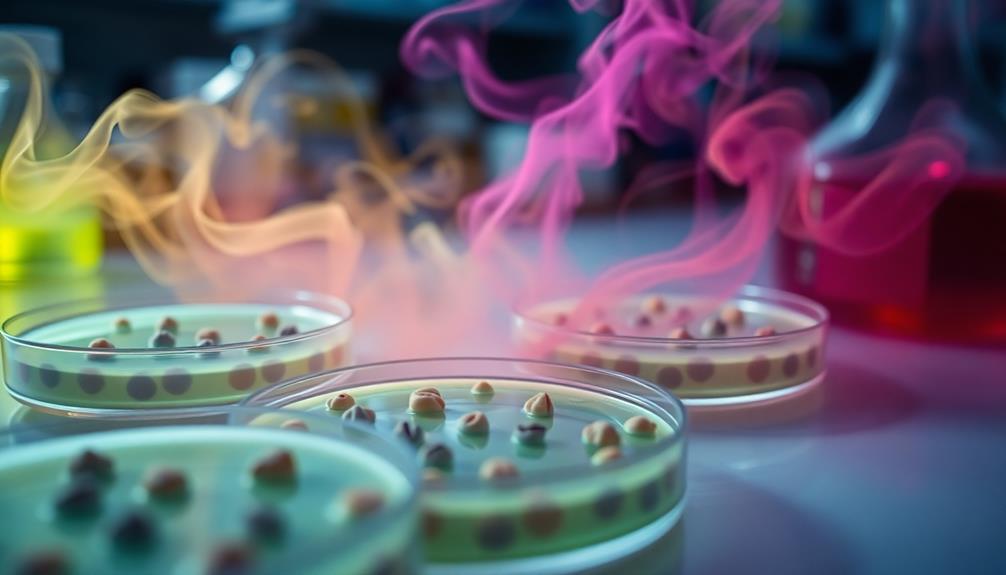
There's no denying the significance of being aware of the fruity aroma associated with Pseudomonas aeruginosa. This unique scent, often likened to grape juice, comes from a compound called aminoacetophenone. Recognizing this smell is important because it helps identify Pseudomonas in various environments, especially in clinical settings.
Unlike the unpleasant odors of other bacteria like Enterobacteriaceae, Pseudomonas aeruginosa's fruity aroma stands out. This distinct olfactory signature can be a crucial indicator of contamination and aids in the early detection of infections.
So, when you catch a whiff of that fruity scent, it might just be your nose alerting you to something significant!
Environmental factors, such as temperature and nutrients, can change how strongly this aroma is released. That's why being aware of your surroundings and the potential presence of this bacteria is essential.
If you're in a lab or healthcare setting, take note of any unusual smells.
Frequently Asked Questions
Does Pseudomonas Smell Like Corn Chips?
Yes, Pseudomonas aeruginosa does smell like corn chips. This distinct odor comes from specific volatile organic compounds it produces, particularly aminoacetophenone, which you can often detect in contaminated clinical samples or environments.
What Do Staph Bacteria Smell Like?
Staph bacteria can smell sweet or fruity, but they might also produce a rancid odor, especially in infected wounds. If you notice unusual smells, it could indicate bacterial colonization, so consider seeking medical evaluation.
What Do Different Bacterias Smell Like?
Different bacteria emit distinct odors. You'll notice Escherichia coli's fecal scent, Clostridium's putrid smell, and Proteus's ammonia-like aroma. Each unique scent reflects their environments and can indicate potential infections or issues in clinical samples.
What Does Pseudomonas Discharge Look Like?
Pseudomonas discharge typically appears thick and can be greenish or bluish-green. It may look opaque and contain pus, signaling a serious infection. If you see this, it's crucial to seek medical evaluation promptly.

